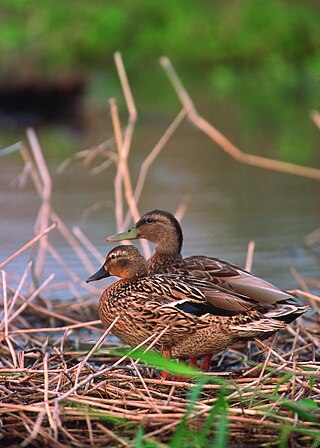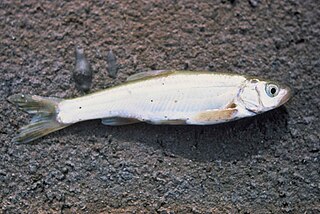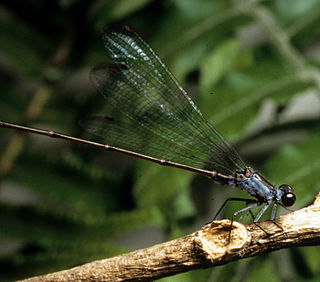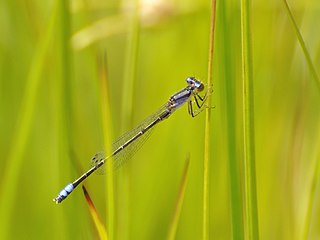
Damselflies are flying insects of the suborder Zygoptera in the order Odonata. They are similar to dragonflies but are smaller and have slimmer bodies. Most species fold the wings along the body when at rest, unlike dragonflies which hold the wings flat and away from the body. An ancient group, damselflies have existed since at least the Lower Permian beginning about 299 million years ago, and are found on every continent except Antarctica.

Punaluʻu Beach is a beach between Pāhala and Nāʻālehu on the Big Island of the U.S. state of Hawaii. The beach has black sand made of basalt and created by lava flowing into the ocean which explodes as it reaches the ocean and cools. This volcanic activity is in the Hawaiʻi Volcanoes National Park. Punaluʻu is frequented by endangered hawksbill and green turtles, which can often be seen basking on the black sand.

The Hawaiian duck or koloa is a species of bird in the family Anatidae that is endemic to the large islands of Hawaiʻi. Taxonomically, the koloa is closely allied with the mallard. It differs in that it is monochromatic and non-migratory. As with many duck species in the genus Anas, Hawaiian duck and mallards can interbreed and produce viable offspring, and the koloa has previously been considered an island subspecies of the mallard. However, all major authorities now consider this form to be a distinct species within the mallard complex. Recent analyses indicate that this is a distinct species that arose through ancient hybridization between mallard and the Laysan duck. The native Hawaiian name for this duck is koloa maoli, or simply koloa. This species is listed as endangered by the IUCN Red List of Threatened Species, and its population trend is decreasing.

The Hine's emerald is an endangered dragonfly species found in the United States and Canada. Populations exist in Illinois, Michigan, Missouri, Ontario, and Wisconsin. Larvae are found in shallow, flowing water in fens and marshes, and often use crayfish burrows. Major threats to the species include habitat loss and alteration, and the species is legally protected in both the United States and Canada.

Megalagrion is a genus of damselflies in the family Coenagrionidae. It contains approximately 26 species, all of which are endemic to Hawaiʻi. Megalagrion damselflies are the only native damselflies in Hawaiʻi, and are referred to as "pinapinao" in ʻ ʻŌlelo Hawaiʻi. Other native Hawaiian dragonfly species include Anax strenuus and Nesogonia Blackburni, which are referred to as "pinao".

The Virgin spinedace is a cyprinid fish of the Virgin River, a tributary of the Colorado River in the United States.

Bidens amplectens, the Waiʻanae kokoʻolau, is a species of flowering plant in the family Asteraceae. It belongs to the genus Bidens, collectively called kokoʻolau or koʻokoʻolau in the Hawaiian language. It is found in coastal and dry lowland habitats in the Waiʻanae Range on Oʻahu. It is threatened by habitat loss due to the spread of invasive weeds and brush fires. The species is also threatened by climate change and habitat degradation, and herbivory. Bidens amplectens is currently listed as endangered under the Endangered Species Act.

Achatinella lila is a species of air-breathing land snail, a terrestrial pulmonate gastropod mollusk in the family Achatinellidae. This species is endemic to the northern Ko‘olau Mountains, Oahu.
The midvalley fairy shrimp, Branchinecta mesovallensis, is a small freshwater crustacean in the Branchinectidae family endemic to shallow ephemeral pools near the middle of California's Central Valley. These vernal pool ecosystems are home to other unique organisms adapted to the ephemeral nature of the water cycle in the pools in California's mediterranean climate.

Megalagrion nesiotes is a species of damselfly in the family Coenagrionidae. Its common name is flying earwig Hawaiian damselfly. In the past, the flying earwig Hawaiian damselfly lived on the islands of Hawaii and Maui, in the U.S. state of Hawaii. Currently, there is only one population left in east Maui. Limited distribution and small population size make this species especially vulnerable to habitat loss and exotic species invasion. The flying earwig Hawaiian damselfly was last found in 2005. Little is known about this species because of the lack of observation. In 2010, the species was federally listed as an endangered species in the United States.

The Pacific Hawaiian damselfly, Megalagrion pacificum, is a species of damselfly that is native to Hawaiian streams and wetlands at low elevations. They are predaceous and territorial narrow-winged damselflies that can be identified by their abdominal markings. In the last century, the populations of Pacific Hawaiian damselflies have decreased due to invasive species, habitat loss, climate change, stream alteration, and urban development. The species was listed as an endangered species under the Endangered Species Act on July 26, 2010.
Dubautia herbstobatae, the Na'ena'e or Keaau Valley dubautia, is an endangered species of shrub which is endemic to Oahu, Hawaii.
Cyanea crispa is a rare species of flowering plant known by the common names crimped rollandia and Koolau Range rollandia. It is endemic to Oahu, where there are no more than fifty individuals remaining in the Koʻolau Range. It is a federally listed endangered species of the United States. Like other Cyanea it is known as haha in Hawaiian.
Cyrtandra subumbellata is a rare species of flowering plant in the African violet family known by the common name parasol cyrtandra. It is endemic to Hawaii, where it is known only from the Koʻolau Mountains on the island of Oahu. By 2008 there were three known populations containing 110 plants, or possibly more. It was federally listed as an endangered species in 1996. Like other Hawaiian Cyrtandra it is called ha`iwale.
Trematolobelia singularis, the lavaslope false lobelia, is a rare species of flowering plant in the bellflower family. It is endemic to Hawaii, where it is known only from the Koʻolau Range on the island of Oahu. It is threatened by the degradation of its habitat. It is a federally listed endangered species of the United States.

Proischnura polychromatica, the mauve bluet, is a small species of damselfly in the family Coenagrionidae. It is endemic to a small area of Cape Province in South Africa. The adult male has a mauve sheen to its dark-coloured body, a bronze-green thorax striped with mauve, and a pale brown abdomen with a bronze-green dorsal stripe. The female is mainly pale brown. The natural habitat of this damselfly is transient pools in stream beds with floating vegetation, especially sedges. Although previously more widespread, it is now known from a single location where it is threatened by the encroachment of cattle and the loss of suitable habitat. For these reasons, the International Union for Conservation of Nature has rated it as "endangered".
Hylaeus facilis is a species of bee, also known by the common name easy yellow-faced bee. It is endemic to Hawaii and known from only two populations. In September 2016, along with six other Hawaiian Hylaeus species, H. facilis was listed for protection under the United States Endangered Species Act. This marked a first listing for any bee species in the US.
Hylaeus mana is a species of bee that is endemic to Hawaii and known from only four populations. In September 2016, along with six other Hawaiian yellow-faced bee species, H. mana was listed for protection under the United States Endangered Species Act. This marked a first listing for any bee species in the US.
Drosophila substenoptera is an endangered species of fly in the species rich lineage of Hawaiian Drosophilidae. It is only found on the island of Oahu,. Historically it was collected throughout the Ko'olau and Wai'anae ranges, but now is only known to occur near the summit of Mt. Kaala. D. substenoptera is a member of the planitibia species group and neopicta subgroup within the picture-wing clade.














